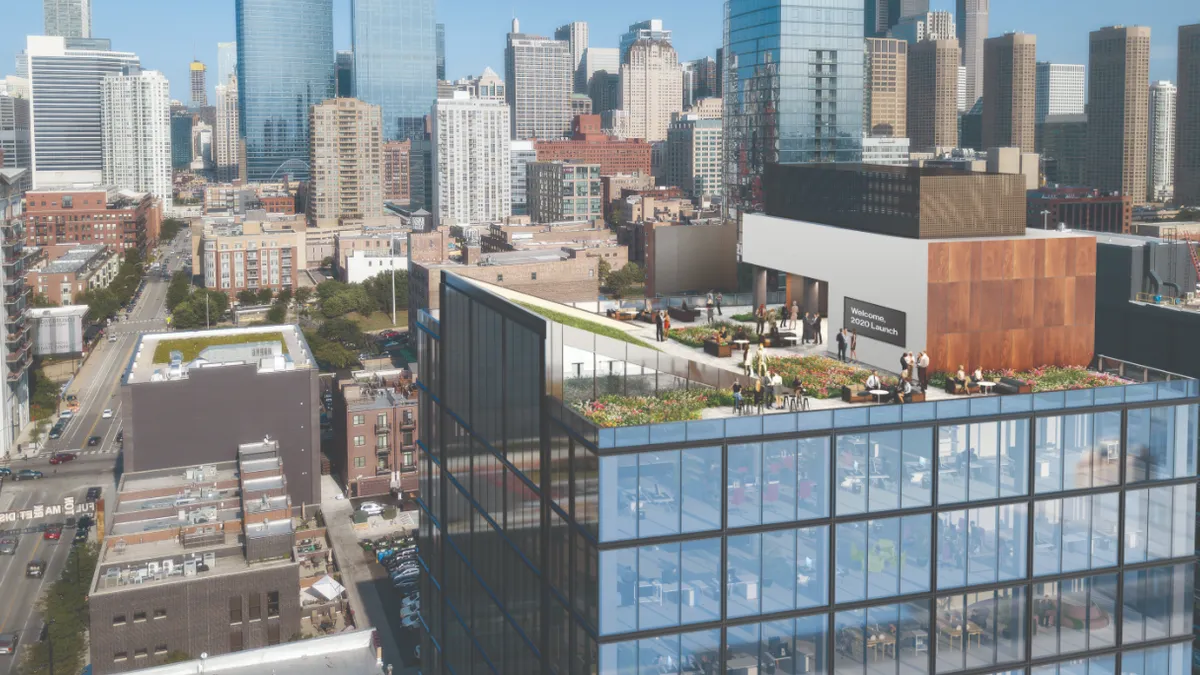When it opens later this summer, a $26 million Chicago office building will be one of the first in the country to boast features designed to address COVID-19 safety concerns.
The 90,000-square-foot Fulton East, which was under construction when the outbreak hit, has been engineered for maximum social distancing, touch-free operation and air and surface sanitization.
"As an under-construction, boutique office building, we fortunately had the opportunity to modify Fulton East’s design in response to COVID-19 in real time," said Bob Wislow, CEO of Fulton East developer Parkside Realty Inc., in a press statement. Chicago-based Clayco is the project's design-builder.
Wislow foresees a move away from large floor-plate buildings filled with multiple companies on each floor sharing bathrooms, corridors and public areas. High-rise buildings with crowded lobbies and long waits for elevators will become less desirable as well, he said.
The 12-story Fulton East, which will house up to 500 people at full occupancy, is constructed with 10,605-square-foot floor plates that facilitate flexible, custom planning options for tenants, he said. Smaller floor plates also provide a greater percentage of natural daylight and views per square foot of occupied space, something that studies have shown improves performance, provides numerous health benefits and even reduces employee sick days, said architect Lamar Johnson in the statement.
In addition, each floor has only three columns, enabling flexibility in office design to easily accommodate social distancing guidelines, including two distinct wet column areas providing the opportunity for two separated cafes and kitchens. Corridors and restrooms are not shared among tenants and each restroom has one fixture more than Chicago city code mandates.
To help reduce the spread of germs and viruses, the building utilizes MAD Elevator Inc.’s Toe-To-Go hands-free elevator system and the airPHX air and surface sanitization system that the company claims reduces up to 99% of viruses, bacteria and mold on surfaces and in the air.
Other health, safety and wellness enhancements include:
- Touch-free thermal scanning at the lobby security desk to check temperatures of people entering the building.
- Touch-free key fob access and security system, pre-wired for future BLE (Bluetooth Low Energy) accessed via a mobile phone.
- Touch-free, after-hours security/building access/intercom/elevator access system.
- Nonshared 9-by-27-foot private outdoor balconies on each floor.
- An 8,000-square-foot rooftop garden for individual use and small group meetings.
- Restroom walls painted with Sherwin-Williams Paint Shield thatis said to kill greater than 99.9% of Staph, MRSA, E. coli and other pathogens within two hours of exposure.
Heightened awareness
Experts predict the coronavirus outbreak has accelerated the move toward more health-related features in buildings such as offices, retail outlets, restaurants and apartments. This heightened awareness means that employers are considering health-related issues over energy savings or aesthetic considerations when evaluating office buildings, according to an Urban Land Institute blog.
"This pandemic and the prospect of future contagions are a permanent tipping point in the rise in prominence of healthy buildings," the ULI authors wrote.
Last month, the International WELL Building Institute (IWBI) launched the WELL Health-Safety Rating for all building and facility types, an evidence-based, third-party verified rating focusing on operational policies, maintenance protocols and design strategies to address a post COVID-19 environment. The WELL Health-Safety Rating is one of the earliest outcomes of IWBI’s Task Force on COVID-19, a group of nearly 600 public health experts, virologists, government officials, academics, business leaders, architects, designers, building scientists and real estate professionals.
In addition, the U.S. Green Building Council (USGBC) recently released four new Safety First Pilot Credits in response to the virus. The credits outline sustainable best practices that align with public health and industry guidelines related to cleaning and disinfecting, workplace reoccupancy, HVAC and plumbing operations. The credits can be used by LEED projects that are certified or are undergoing certification.













